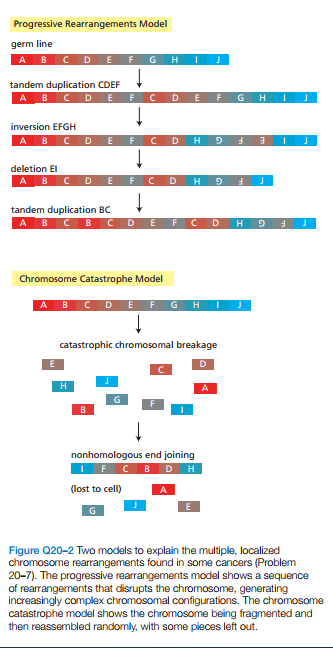Progressive Rearrangements Model germ line ABCD EF G H I tandem duplication CDEF BCD EF C DE F G H I inversion EFGH AB C E F C D H deletion El A B C DE F CD tandem duplication BC A B BCD EFC D H 9 J Chromosome Catastrophe Model A BCDE F GHIJ catastrophic chromosomal breakage E D A B nonhomologous end joining IFC B D (lost to cell) A G Figure Q20-2 Two models to explain the multiple, localized chromosome rearrangements found in some cancers (Problem 20-7). The progressive rearrangements model shows a sequence of rearrangements that disrupts the chromosome, generating increasingly complex chromosomal configurations. The chromosome catastrophe model shows the chromosome being fragmented and then reassembled randomly, with some pieces left out.
A small fraction—2 to 3%—of all cancers, across
many subtypes, displays a quite remarkable phenome-
non: tens to hundreds of rearrangements that primarily
involve a single chromosome, or chromosomal region.
The breakpoints can be tightly clustered, with several in a
few kilobases; the junctions of the rearrangements often
involve segments of DNA that were not originally close
together on the chromosome. The copy number of various
segments within the rearranged chromosome was found
to be either zero, indicating deletion, or one, indicating
retention.
You can imagine two ways in which such multi-
ple, localized rearrangements might happen: a progressive
rearrangements model with ongoing inversions, deletions,
and duplications involving a localized area, or a cata-
strophic model in which the chromosome is shattered into
fragments that are stitched back together in random order
by nonhomologous end joining (Figure Q20–2).
A. Which of the two models in Figure Q20–2 accounts
more readily for the features of these highly rearranged
chromosomes? Explain your reasoning.
B. For whichever model you choose, suggest how
such multiple rearrangements might arise. (The true
mechanism is not known.)
C. Do you suppose such rearrangements are likely
to be causative events in the cancers in which they are
found, or are they probably just passenger events that are
unrelated to the cancer? If you think they could be driver
events, suggest how such rearrangements might activate
an oncogene or inactivate a tumor suppressor gene.

Step by step
Solved in 5 steps with 2 images






